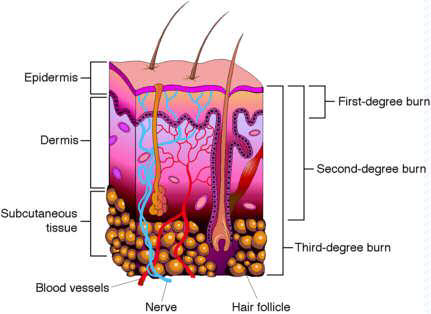Burn Mechanism and Classification
Burn Mechanism and Classification
Burn is an injury to the skin or tissue results from excessive exposure to thermal, electrical, chemical and radioactive agents. Determination of the size and depth of a burn sets the guidelines for resuscitation.
Mechanism of Burn
- Contact: Direct contact with hot surface
- Scald: is an injury to the skin caused by touching a very hot liquid or steam. Also called wet burn
- Flash: A burn caused when a body part is briefly exposed to a source of intense heat.
- Flame: It is a hot glowing body ignited gas generated by something on fire which usually causes full thickness burn
- Chemical: Caused by exposure to acids, alkali or other chemical substances. Tissue damage will continue until the causes are removed. Treatment includes immediate irrigation with large amounts of tap water. After irrigation, the burns should be covered with saline-soaked pads. All body parts must be thoroughly irrigated, including those not believed to be involved
- Electrical: Electrical burns may be from electric voltage, or lightning injury. Most electrical burn injuries occur in the workplace for adults and in the home for children. Electrical burns due to lightning have the highest mortality. The hallmarks of electrical burns are the presence of contact points, which are hard, leathery, and sometimes charred, circumscribed lesions. Tissue damage is most severe in the regions immediately around the contact points, with tissue necrosis extending for significant distances.
Classification of Burn by Depth
Burn depth is classified as first, second, or third degree (Figure 8.1 and Table 8.1). First degree burns result from damage to the superficial layers of the epidermis. They are characterized by erythema (redness on the skin) and pain. No open wound is produced and fluid loss and systemic response is minimal. First degree burns are not considered significant and they are not considered when burn size is calculated for fluid resuscitation. Areas of first degree burn have to be appreciated and ignored in calculations of burn size for resuscitation.
Extension of thermal damage to the dermis results in second degree burns. They may be further classified as superficial or deep second degree burns. Superficial injury results in a very painful wound that is blistered or weeping. The wound is pink and blanches with light pressure. This wound typically heals within 10-20 days with minimal to no scarring if infection is avoided. Nevertheless, areas of superficial second degree burn exceeding 20 percent TSBA may require fluid resuscitation and monitoring.

Table 8.1 Degree of Burn and Depth
| Degree of Burn | Depth |
|---|---|
| First degree | Epithelium |
| Superficial second degree | Superficial dermis |
| Deep second degree | Deep dermis |
| Third degree | Destruction of all layer of tissue including subcutaneous tissue and nerve ending |
Deep second degree burns extend to the deep dermis. The wounds are drier and are red rather than pink. These burns will take more than 20 days to heal and can result in significant hypertrophic scarring.
Coagulation of the entire dermis results in third degree burns. These wounds may be charred (blacken) or white to deep red. They are insensate to pain, although pressure may be noted with palpation.
Size of Burn
The size of the burned area (Figure 8.2) as a fraction of the total body surface area (TBSA) is estimated by the rule of nines. In an adult, the head contributes to 9%; the upper extremities, 18%; the trunk, 36%; and the lower extremities, 36% of the TBSA. These proportions are somewhat different in children, depending on the age and size.

Major burns are full-thickness burns involving >10% of the TBSA; partial-thickness burns covering >25% of TBSA in adults and over 20% at the extremes of age; burns involving the face, hands, feet, or perineum; inhalation, chemical, and electrical burns; and burns in patients with severe preexisting medical disorders are considered to be major burns. In an adult the palm of the hand is approximately 1% of surface area.